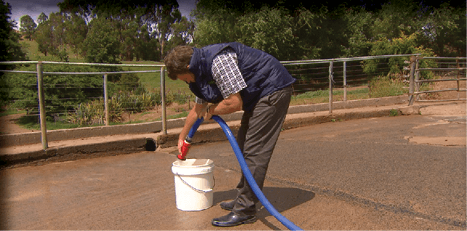
What are the steps to getting the SB into my pond?
- Empty the pot of Slurry Bugs powder into a bucket. How many canisters will depend on the size of your pond and how bad the crust is (see calculation below).
- Mix it up with water. Because Slurry Bugs are live bacteria in a powdered form, always wear glasses and a face mask when stirring.
- To get the Slurry Bugs into your pond, tip the contents out and wash itdown the outlet pipes.
How much do I put in my pond to begin with?
- The first thing to do is work out the cubit metres of your pond. For example, a full pond that measures 20m x 15m and is 3m deep = 20 x 20 x 3 = 1200 cubic metres.
- Ideally, you'd want to empty the pond till it contained only 1 metre of effluent. This will give the Slurry Bugs a chance to dominate the pond quicker. So working with the pond above, if we emptied it to 1m deep of effluent, its total cubic metres would be 20 x 20 x 1 = 400
- 1 pot of Slurry Bugs treats 450 cubic metres of effluent. When introducing Slurry Bugs for the first time, we double the dosage to enable the Slurry Bugs to gain dominance. This is crucial. Going too light will not allow the good bacteria to gain a proper foothold. So the pond above will need enough Slurry Bugs to cover 800 cubic meters (400 x 2) = 2 pots of Slurry Bugs

How OFTEN do I need to keep topping up the Slurry Bugs?
How often you top up your pond with Slurry Bugs depends on how much effluent is going into your pond. Factors that influence this are:
From where the effluent level is at the start of treatment, use a spray can to mark 1m above that current level on the side of the pond. Also note the date. When the incoming effluent reaches this mark, call your Slurry Bugs agent. By combining your pond volume + the rate effluent increase, they will be able to give you a simple set of instructions that tell you how much + how often to put Slurry Bugs in your pond. It's not hard. The key is to consistently follow the instructions.
- How many cows you have
- How much water you use when hosing down
From where the effluent level is at the start of treatment, use a spray can to mark 1m above that current level on the side of the pond. Also note the date. When the incoming effluent reaches this mark, call your Slurry Bugs agent. By combining your pond volume + the rate effluent increase, they will be able to give you a simple set of instructions that tell you how much + how often to put Slurry Bugs in your pond. It's not hard. The key is to consistently follow the instructions.
Can I stop using Slurry Bugs once the crust has gone?
Fair question. Remember that the battle against pond crust is a biological fight: It is Good Bugs vs. Bad Bugs. Always. So here's the scenario: after using Slurry Bugs, your pond becomes clean and liquefied. That means that your Slurry Bugs are dominating and that the pond is in an aerobic state, which is good.
At some point you'll pump some of that nutrient-rich effluent onto your pasture. At the same time, new, raw effluent will enter the pond and that effluent is dominated by the bad bugs - the Anaerobic Bacteria. If left unchecked, the entry of these bad bacteria will tip the condition of the pond back to an anaerobic state = where the bad guys outnumber the good guys. If that occurs, the crust will return.
To keep your pond in good aerobic state, you simply keep the level of Slurry Bugs higher than the bad bacteria.
At some point you'll pump some of that nutrient-rich effluent onto your pasture. At the same time, new, raw effluent will enter the pond and that effluent is dominated by the bad bugs - the Anaerobic Bacteria. If left unchecked, the entry of these bad bacteria will tip the condition of the pond back to an anaerobic state = where the bad guys outnumber the good guys. If that occurs, the crust will return.
To keep your pond in good aerobic state, you simply keep the level of Slurry Bugs higher than the bad bacteria.

